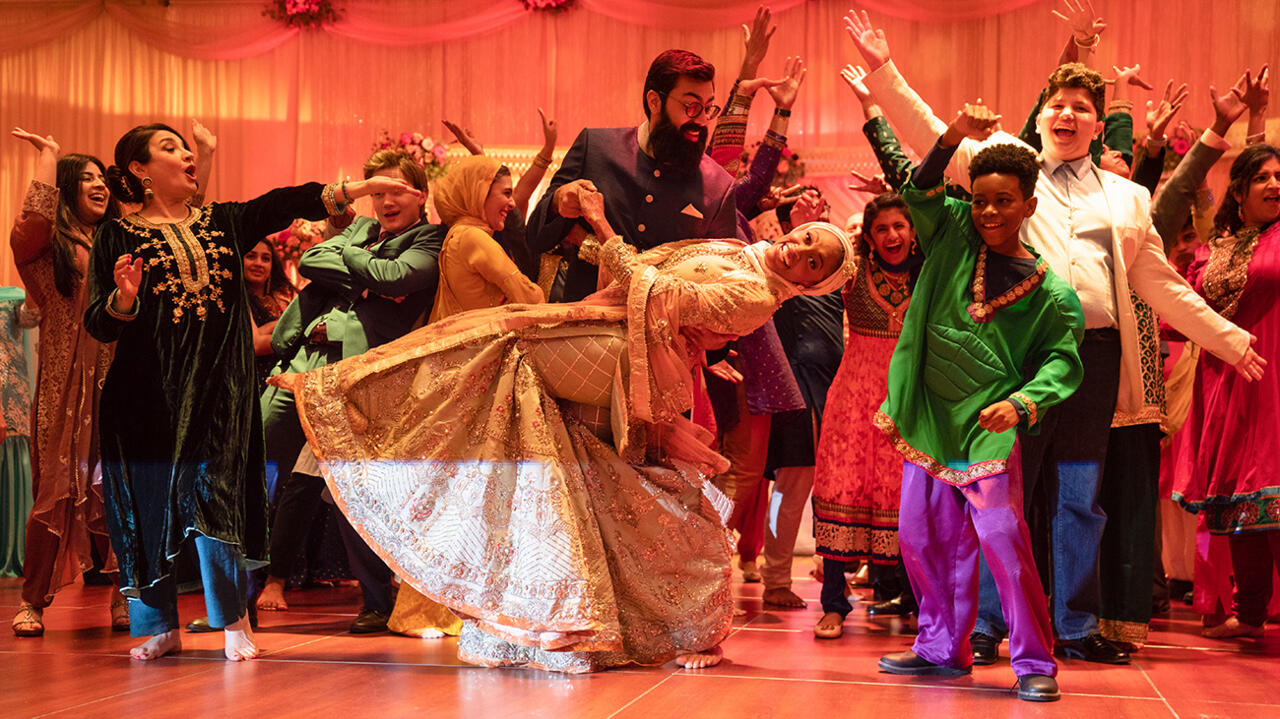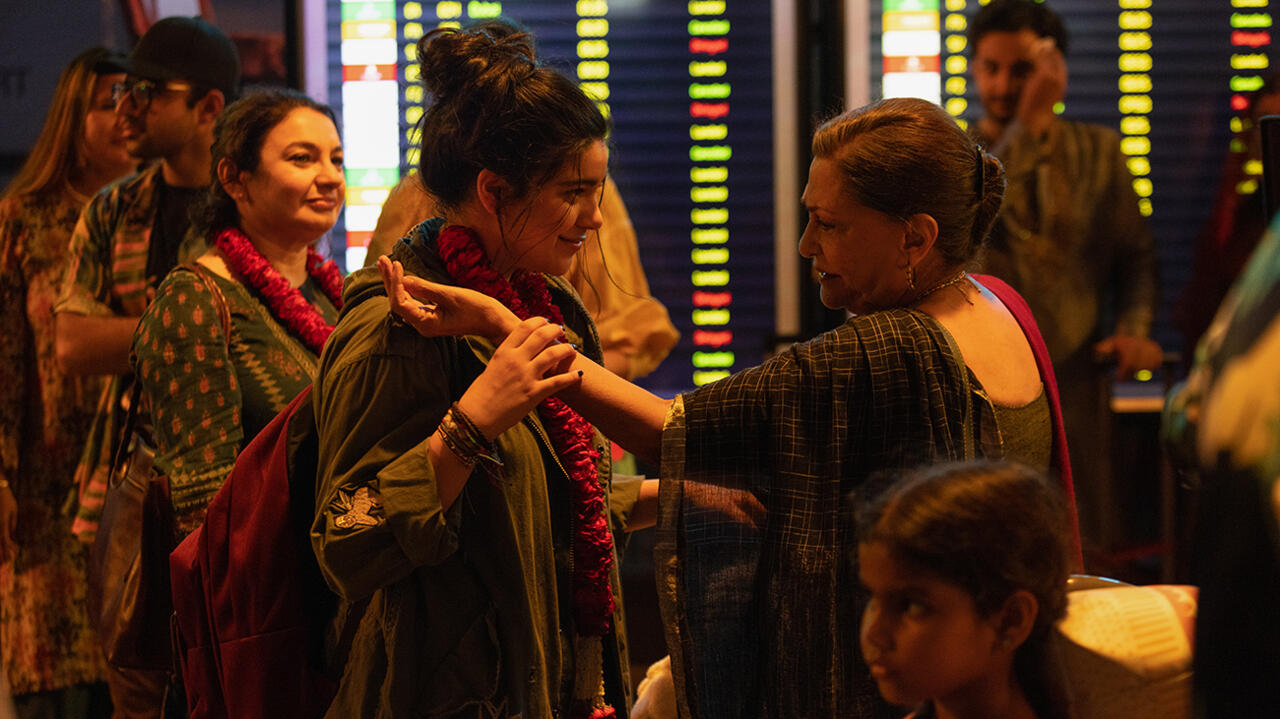On Ms. Marvel, when Kamala Khan's brother Aamir finds her hanging out with a boy named Kamran at a restaurant, he pokes fun by calling him "Haram-dot-Kamran"--"haram" being a word used to refer to so something as "forbidden" in Islam. I cackled because it gave me a new way to tease my husband, Kamran, but also because it was so pleasant hearing familiar names on screen and pronounced correctly. This level of relatability isn't something I envisioned from a Disney+ superhero show set in the Marvel Cinematic Universe–not for someone of my background as a South Asian Muslim. In the lead-up to its release, I didn't know how to feel about the culture and religion it aimed to represent, and my skepticism felt warranted given that it's the same MCU that made Eternals' Kingo, one of precious few South Asian characters in Marvel, a Bollywood star. He could have been anything, but they went with a stereotype.
However, a couple of episodes into the first season, Ms. Marvel has surpassed my expectations by depicting South Asian culture in ways that are both subtle and uncompromising. It goes beyond casting Pakistani-Canadian actor Iman Vellani as the bright-eyed main protagonist Kamala Khan. Ms. Marvel is a culture-focused narrative that features a range of Muslim characters that are purposeful and important parts of the story. As an artist who does primarily South Asian-centered art, I couldn't get enough of the music and artwork that are showcased each episode. And it was common for me to go on social media and see South Asian artists ecstatic that their art was featured in the show. Moments like these make representation valuable because the good that comes from it is tangible; the show makes it easy to draw a line from a moment on screen, to the impact it is having on people in the real world, whether that's South Asian artists seeing their work in a Disney and Marvel production, or young kids seeing people that look like them fighting for good. This, in turn, cements Ms. Marvel as a well-rounded show built by South Asians people and led by South Asian women, that will have a lasting impact on underrepresented communities, if not the Marvel Cinematic Universe.
What makes the representation in this show shine is that it's happening everywhere, even where you least expect it. Ms. Marvel embraces the ordinary life of a brown teenager in America and her relationships with family and friends with nuance, particularly when it concerns the push-and-pull that comes from having one foot in the western culture of New Jersey, where Kamala is being raised, and the other foot in the culture of Pakistan and India, where her family came from. They also do an excellent job of exploring both culture and religion, which can easily be conflated by those who don't have the personal life experiences to speak to the difference between them. In the early episodes of Ms. Marvel celebrations like Eid and weddings are key plot points alongside the examination of real-world issues of xenophobia and Islamophobia, most obviously perpetrated by the Department of Damage Control (DODC), a secretive government agency that, on paper, is attempting to apprehend the vigilante Ms. Marvel, but functionally ends up targetting any and all brown people, much like what happened in the real world post-9/11. This type of representation happens when the story is told through people who have lived through the South Asian American experience and can share an authentic perspective.

Right off the bat, Kamala expresses appreciation and curiosity for her heritage when showing off her necklace pendant that says her name in Arabic and gives her Captain Marvel cosplay a Pakistani flair with her bangle, yet she maintained her rebellious, free-spirited nature without relying on the tiresome stereotypical or internalized racist tropes. Loving who you are and being humanized as a brown Muslim in America is hard to find on-screen.
The authenticity in Ms. Marvel comes from the fact that it speaks directly to the people that it is trying to represent and does so without allowing the need to make sure those outside of the South Asian community understand everything that is on-screen. At its most basic, that can be a simple pun like the Illuminaunties, which anyone can find the humor in, but it goes a step further by including a joke about a shoe thief at the mosque is incredibly specific, as are the mosque factions, the wearisome shopping trips with parents to the local desi markets, and elaborate wedding dances. Ms. Marvel's brilliance is in the things that are left unexplained which, for a change, overtly nod at Pakistanis, Muslims, and South Asians, instead of giving them the passing awkward winks they're used to. These are the things that others may have easily missed, but most Muslims and South Asians caught right away. The show uses moments like Kamala's brother Aamir reciting the Ayatul Kursi--a verse from the Quran recited when needing protection or to ward off danger or evil--when his sister falls unconscious at the dinner table to be humorous and witty, but only those who know the verse and understand how he has exaggerated the situation really get the full extent of the joke. Even when Kamala says Bismillah (which means In the name of God) before she begins her driving test and fails--it reveals the boldness of Muslims trying to do things without preparation beforehand and hoping that divine intervention will get them through (god doesn't help the lazy, kids). Even the collective Muslim disgust of the DODC's agents walking on the mosque's carpet with their shoes on is something that could be missed by many without knowledge of mosque culture and best practices. Although Kamala's mother Muneeba has a personality pretty different from my own mum's, her packing a bag full of food for Kamala's best friend Bruno is a perfect indication of how most of our mums are incapable of letting people leave the house empty-handed. My husband caught a glimpse of a group dancing at the mehndi in preparation for the wedding and it reminded him of his multiple dance practices for our recent wedding celebrations.
I've never experienced such relatability in western media and never seen desi Muslim kids growing up in America in as authentic a way. Although I'm not Pakistani, I am repeatedly presented with touchstones that many South Asians can claim. For example, a brief scene in Episode 4, set in Karachi, Pakistan, involves Kamala and her grandmother Sana having a touching conversation out on a terrace. For a few seconds during this, you can hear the Azaan (call to prayer in Islam), where the voice echoes above the bustle of the streets at sunset--familiar scenery to my visits back to my Muslim-populated city in India.

Perhaps the most important depiction in the series, and what makes it really hit home, is of the tension between India and Pakistan, which is a core part of Ms. Marvel's narrative. Although the South Asian subcontinent is known for sharing culture between cities and countries, there are still geopolitical issues that define the dynamics between them. Most relevant to Ms. Marvel is India and Pakistan's turbulent relationship. Ms. Marvel acknowledges this by repeatedly talking about the Partition of Pakistan and India after the British Empire lost its rule over those lands. Even though Sana gave a sugar-coated reasoning behind the division, her underlying message is that holding tightly to a national identity won't do much good for anyone. Similarly, this history meshes with the story of the Clandestine who were also displaced from their home--giving heritage and political history a purpose. To see these themes explored in mainstream media is unprecedented, to see them explored in the Marvel Cinematic Universe feels unimaginable. And yet, here we are, with the same character that blazed a trail for South Asian representation in comics doing it again on TV. And in both cases, the creative team behind Ms. Marvel, on comics and TV, have involved South Asians with lived experiences to pull from.
Ms. Marvel's portrayal opens new horizons for what representation and relatability can mean for South Asians living in America. Most importantly, though, it doesn't solely rely on culture and religion. It couches these aspects of the show in the trials and tribulations faced by all teenagers, which is crucial to making it relatable for anyone and everyone. You may not be from Pakistan or a Muslim, but you definitely know what it's like to have a goth phase as the subject of a family discussion, or find yourself desperately crushing over someone that you think is out of your league.

Despite being laser-targeted at a niche group, Ms. Marvel manages to be eminently relatable by ensuring that, at its core, it remains a very human coming of age story. For people like me, it evokes laughter, sadness, and pure excitement solely because I haven't been able to relate to media like this. But amidst the action, talk of djinn, and history lessons on the partition are discreet moments of nuanced portrayals of Muslims, which is scarce in American media. Ms. Marvel may be the story of how a young girl became a superhero, but its depiction of the ordinary, everyday lives of Muslims and South Asians is what really make it empowering.

Log in to comment